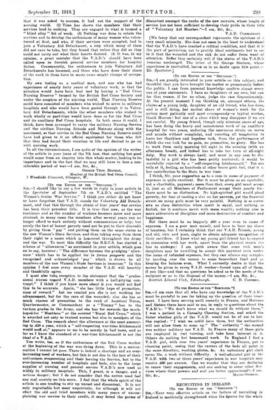period of the war are taken into account. The two
official White Papers Cd. 8168 and Cd. 8390, both issued in 1916. taken in conjunction with the figures of Lord French's present recruiting scheme, give all the facts. The first was issued by Lord Wimborne in January, and the second, issued in November, brings the figures Hp to the middle of October of -that year. At that date all Ireland had produced 130,241 recruits, of whom 66,674 had come from Ulster, leaving 63,567 for the rest of the country. There were in all 547,827 men of military age, but by a series of deductions of men "considered" indispensable or " estimated " as physically unfit the authorities reduced the total of those left available for military service to 161,239. Belfast had given 38,543 recruits, leaving only 7,806 "available," whereas Dublin with 21;412 recruit-3 was left with 21,970 "available." These figures must be kept in mind when considering the present recruiting returns from these two leading areas.
The returns under the French scheme are given by "areas " and not by cities. The Belfast area, including the counties of Down and Antrim, had given up till Saturday last 2,078 of its quota of 8,500, whereas the Dublin area, including Dublin City and County and five other counties, had given only 1,620 out of a quota of 11,700. The fact that the Dublin quota is so much larger than that of Belfast is the natural result of the circumstances that Belfast had already given 9,000 more recruits than Dublin, and that the number of men "indispensably "employed in Belfast in shipbuilding, aeroplane construction, and munitions generally is enormously greater than that in Dublin. Belfast City left ith only 7,806 available men has thus to be compared with Dublin with its untapped reservoir of 21,970. Similarly in the case of Londonderry County and City the recruits were 4,636, leaving only 4,150 available, whereas Cork was left with 16,218 available and Limerick with 6,551. It is evident from this that the percentage of recruits in proportion to the number officially reported as " available. " is enormously greater in the North- Eastern area than in the Southern groups. In fact, it may be stated generally that recruiting in this district is not unsatis- factory, and that the fear of hostile action by the Sinn Feiners has played a very minor part in holding back recruits except in the more remote districts where isolated men feel that those left behind might be exposed to danger. There are of course some amongst us, as there were in England and in Scotland, under similar conditions, who will hold back until they are sent for; but I can state confidently that not only was there a very satis- factory response to the first call, but that there has been a steady stream of recruits ever since. If -the figures seem small, that is *imply accounted for, as shown above, by the fact that the number available for recruiting is also small. Under the two schemes -Ulster, with a population of 1,581,696, had, till September 14th, given 69,380 recruits. The other three provinces, with a population ef 2,808,523, had given 66,934.—I RBI, Sir. &C., 11C011 T. BARRIE.
The Manor House, Coleraine, Co. Derry.



































 Previous page
Previous page